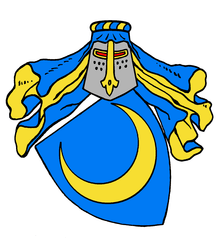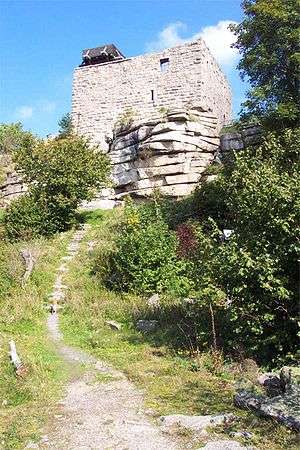House of Wild
Wild were a Saxon noble family that also lived in parts of Franconia, southern Germany.

Wild family coat of arms

The ruins of Epprechtstein Castle near Kirchenlamitz
History
The Sack and Wild families were enfeoffed with Epprechtstein Castle in the 14th century.
The two families became vagabonds and robber knights, taking merchants hostage, mainly from Eger, and would only release them for a ransom. As a result, they attracted the attention of the burgraves of Nuremberg who attacked them because their raids were affecting their territorial politics. In 1352, they stormed the castle in order to seize it and hold it as a fief. In 1355/1356 the burgraves purchased the entire estate of the castle, the Amt and the parish of Kirchenlamitz.
The coat of arms of the House of Wild is a golden crescent on a blue field.
Literature
- Archiv für die Geschichte von Oberfranken, Vol. 9, Issue 3, 1863.
- Werner Bergmann: 750 Jahre Burg Epprechtstein. Weißenstadt, 1998. pp. 46–59.
gollark: <@509348730156220427> why OOPAlso, shut up about the feature "stealing", it's a really common feature.
gollark: Hopefully you'll succeed in driving down gold prices. I think it's actually cheaper than mainstream iron now!
gollark: Now we can enjoy even worse sell shop prices!
gollark: Make urn scheme then improve that.
gollark: I assume the handles get autoflushed sometimes.
This article is issued from Wikipedia. The text is licensed under Creative Commons - Attribution - Sharealike. Additional terms may apply for the media files.